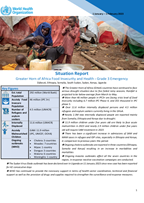.tmb-1920v19e1.jpg)

Drought and food insecurity in the greater Horn of Africa

Donate
© WHO / Billy Miaron
Overview
Millions in the greater Horn of Africa are facing acute
hunger as the region faces one of the worst droughts in recent decades,
compounded by years of conflict and instability, the impact of the COVID-19
pandemic and rising food prices due to, in part, the war in Ukraine.
As families face severe food insecurity, many have left
their homes in search of food and water, and pasture for animals. Large-scale displacement is often accompanied by
a deterioration in hygiene and sanitation. Outbreaks of infectious diseases are
a major concern, especially when combined with low existing vaccination
coverage and health service availability.
As people become increasingly food insecure, they also must
make the impossible choice between food and healthcare, even as nutritional
deficiencies make them increasingly vulnerable to disease. This is particularly
true for children, for whom the combination of malnutrition and disease can
prove fatal.
With malnutrition and displacement, the need for health
services will increase as people become weaker and more vulnerable to disease.
WHO is coordinating with partners in the health sector and
beyond to ramp up its response in the region to avert the worst effects of food insecurity and to give people access to the health services they need.
Along with countering the consequences of malnutrition, WHO
is helping countries to prepare for outbreaks of diseases like cholera, measles
and malaria. This includes improving surveillance systems for communicable
diseases to identify and respond to new outbreaks quickly.
Among affected populations, WHO helps ensure that essential health services like those for sexual and reproductive health, treatment for chronic infectious diseases such as tuberculosis and HIV, as well as mental health services as people are at high risk of violence and distress can continue without disruption.
Publications
All →
Situation report: Greater Horn of Africa food insecurity and health - grade 3 emergency: 1 February —...
Countries in the greater Horn of Africa continued to face extreme weather events including drought due to five failed rainy seasons and flooding...

Situation Report: Greater Horn of Africa Food Insecurity and Health - Grade 3 Emergency — 1 January 2023...
The Greater Horn of Africa (GHoA) countries have continued to face serious drought situation due to five failed rainy seasons. Rainfall is projected...

Situation Report: Greater Horn of Africa Food Insecurity and Health - Grade 3 Emergency — 15 November...
The Greater Horn of Africa (GHoA) countries are facing a serious food insecurity crisis due to failed rainy seasons as well as flooding in other areas...

Situation Report: Greater Horn of Africa Food Insecurity and Health - Grade 3 Emergency— 10 October 2022...
The humanitarian crisis in the Greater Horn of Africa (GHoA) continues as a large part of the region is battling the worst drought in at least...

Joint UNHCR & WHO report - October 2022
A food insecurity crisis is a health crisis, with a last- ing impact on the health of the displaced community. Health risks increase while access to healthcare...

Situation Report: Greater Horn of Africa Food Insecurity and Health - Grade 3 Emergency— 10 October 2022
The drought in the Greater Horn of Africa (GHoA) is predicted to continue into the late annual rainy season. For the first time in 40 years, four consecutive...

Situation Report: Greater Horn of Africa Drought and Food Insecurity — 16 September 2022
The Greater Horn of Africa Region continues to face a dire food insecurity crisis driven by several evolving factors such as extreme weather events (floods,...

Situation Report: Greater Horn of Africa Drought and Food Insecurity — 28 August 2022
The Greater Horn of Africa Region continues to face a dire food insecurity crisis driven by several evolving factors such as extreme weather events (floods,...

The Greater Horn of Africa is experiencing one of the worst food insecurity situations in decades. It is estimatedthat more than 37 million people are...

Key Highlights:The greater Horn of Africa is facing a major humanitarian crisis due to rising food insecurity driven by a toxic mix of extreme weather...

Countries in the greater Horn of Africa are facing one of the worst episodes of food insecurity seen in decades The Horn of Africa is experiencing one...







